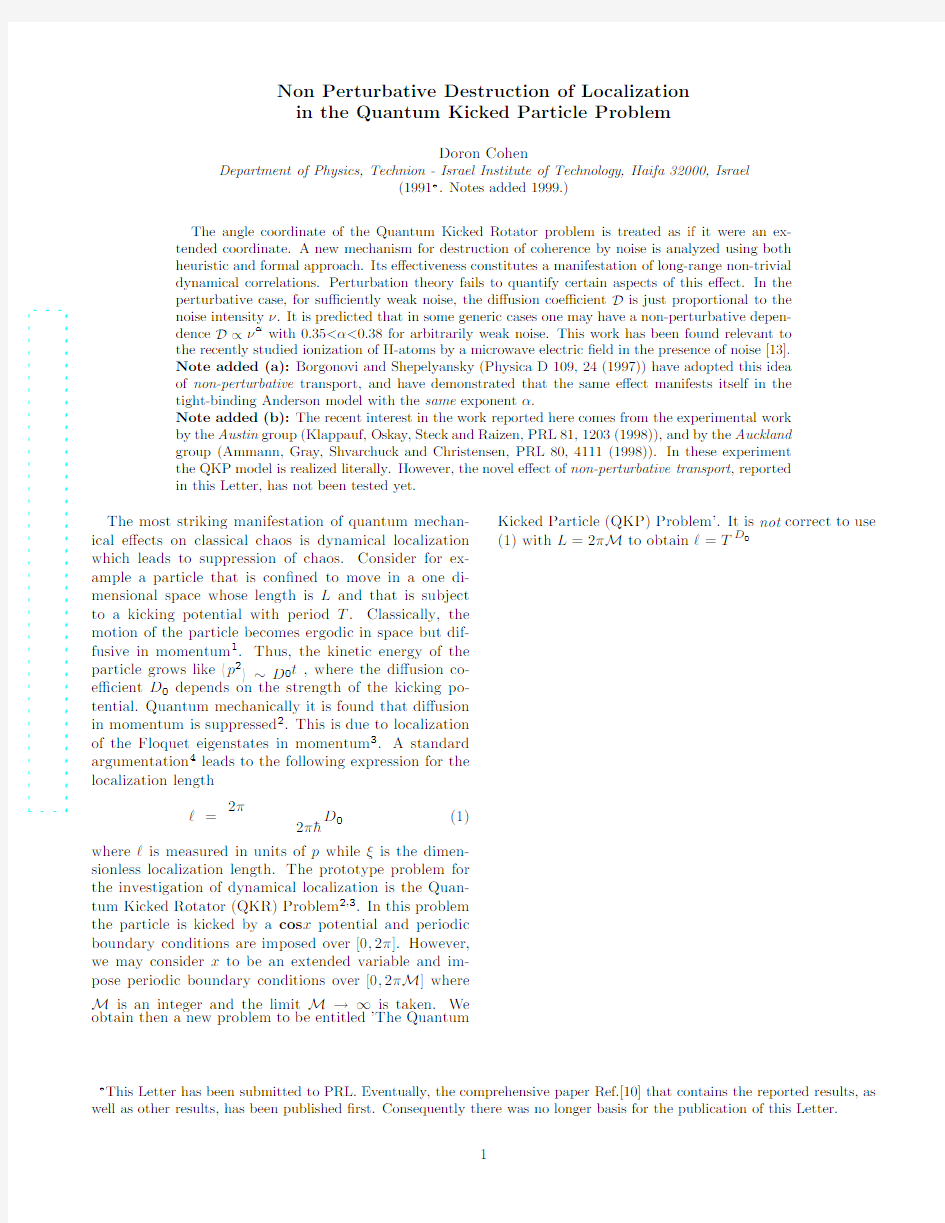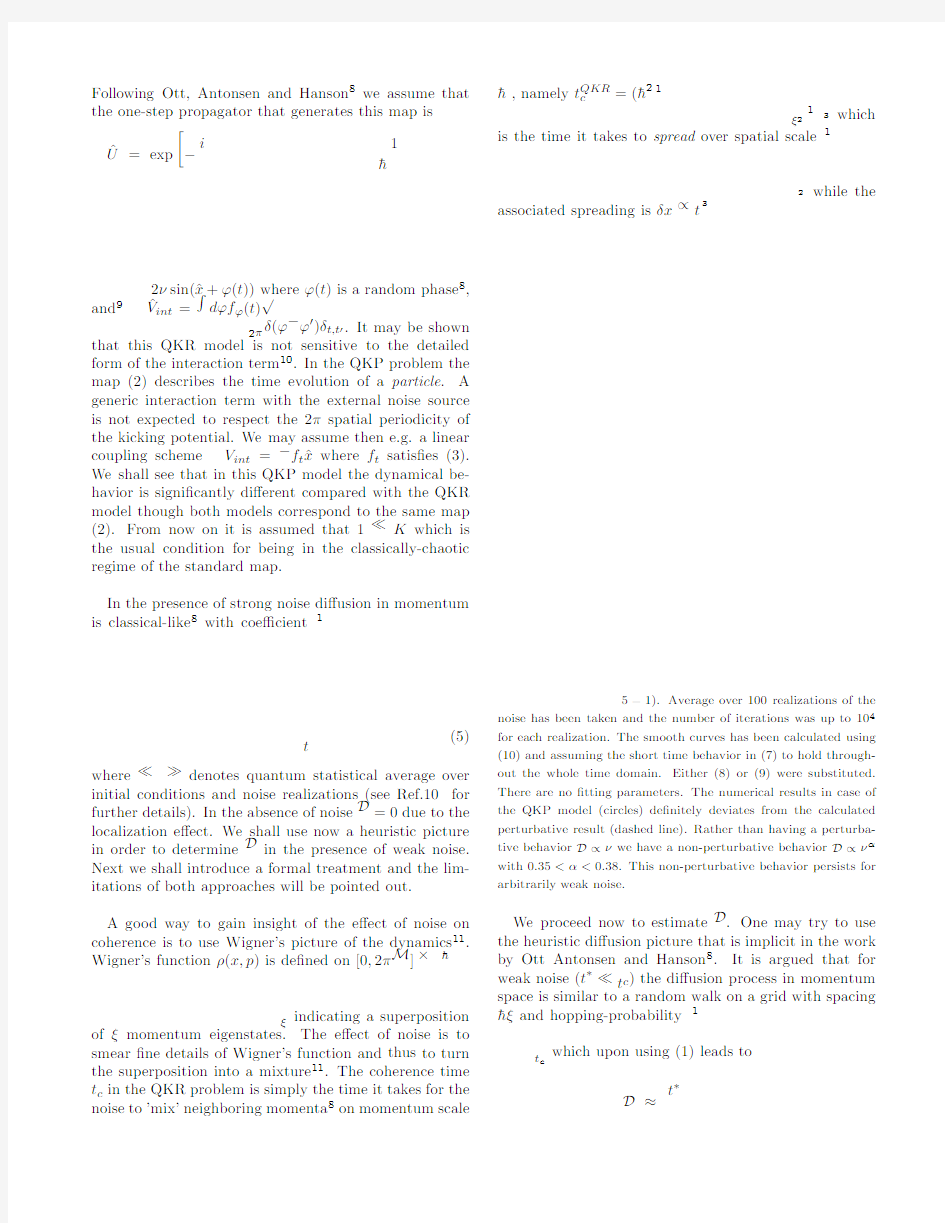

a r X i v :c h a o -d y n /9909016v 1 9 S e p 1999
Non Perturbative Destruction of Localization in the Quantum Kicked Particle Problem
Doron Cohen
Department of Physics,Technion -Israel Institute of Technology,Haifa 32000,Israel
(1991?.Notes added 1999.)
The angle coordinate of the Quantum Kicked Rotator problem is treated as if it were an ex-tended coordinate.A new mechanism for destruction of coherence by noise is analyzed using both heuristic and formal approach.Its e?ectiveness constitutes a manifestation of long-range non-trivial dynamical correlations.Perturbation theory fails to quantify certain aspects of this e?ect.In the perturbative case,for su?ciently weak noise,the di?usion coe?cient D is just proportional to the noise intensity ν.It is predicted that in some generic cases one may have a non-perturbative depen-dence D ∝ναwith 0.35<α<0.38for arbitrarily weak noise.This work has been found relevant to the recently studied ionization of H-atoms by a microwave electric ?eld in the presence of noise [13].Note added (a):Borgonovi and Shepelyansky (Physica D 109,24(1997))have adopted this idea of non-perturbative transport,and have demonstrated that the same e?ect manifests itself in the tight-binding Anderson model with the same exponent α.
Note added (b):The recent interest in the work reported here comes from the experimental work by the Austin group (Klappauf,Oskay,Steck and Raizen,PRL 81,1203(1998)),and by the Auckland group (Ammann,Gray,Shvarchuck and Christensen,PRL 80,4111(1998)).In these experiment the QKP model is realized literally.However,the novel e?ect of non-perturbative transport ,reported in this Letter,has not been tested yet.
The most striking manifestation of quantum mechan-ical e?ects on classical chaos is dynamical localization which leads to suppression of chaos.Consider for ex-ample a particle that is con?ned to move in a one di-mensional space whose length is L and that is subject to a kicking potential with period T .Classically,the motion of the particle becomes ergodic in space but dif-fusive in momentum 1.Thus,the kinetic energy of the particle grows like p 2 ~D 0t ,where the di?usion co-e?cient D 0depends on the strength of the kicking po-tential.Quantum mechanically it is found that di?usion in momentum is suppressed 2.This is due to localization of the Floquet eigenstates in momentum 3.A standard argumentation 4leads to the following expression for the localization length
?=
2π
2πˉh
D 0
(1)
where ?is measured in units of p while ξis the dimen-sionless localization length.The prototype problem for the investigation of dynamical localization is the Quan-tum Kicked Rotator (QKR)Problem 2,3.In this problem the particle is kicked by a cos x potential and periodic boundary conditions are imposed over [0,2π].However,we may consider x to be an extended variable and im-pose periodic boundary conditions over [0,2πM ]where M is an integer and the limit M →∞is taken.We obtain then a new problem to be entitled ’The Quantum
Kicked Particle (QKP)Problem’.It is not correct to use
(1)with L =2πM to obtain ?=T D 0
?
This Letter has been submitted to PRL.Eventually,the comprehensive paper Ref.[10]that contains the reported results,as well as other results,has been published ?rst.Consequently there was no longer basis for the publication of this Letter.
1
Following Ott,Antonsen and Hanson8we assume that the one-step propagator that generates this map is ?U=exp ?iˉh1
2νsin(?x+?(t))where?(t)is a random phase8, and9?V int= d?f?(t)√2πδ(???′)δt,t′.It may be shown that this QKR model is not sensitive to the detailed form of the interaction term10.In the QKP problem the map(2)describes the time evolution of a particle.A generic interaction term with the external noise source is not expected to respect the2πspatial periodicity of the kicking potential.We may assume then e.g.a linear coupling scheme V int=?f t?x where f t satis?es(3). We shall see that in this QKP model the dynamical be-havior is signi?cantly di?erent compared with the QKR model though both models correspond to the same map (2).From now on it is assumed that1?K which is the usual condition for being in the classically-chaotic regime of the standard map.
In the presence of strong noise di?usion in momentum is classical-like8with coe?cient1
t
(5)
where??denotes quantum statistical average over initial conditions and noise realizations(see Ref.10for further details).In the absence of noise D=0due to the localization e?ect.We shall use now a heuristic picture in order to determine D in the presence of weak noise. Next we shall introduce a formal treatment and the lim-itations of both approaches will be pointed out.
A good way to gain insight of the e?ect of noise on coherence is to use Wigner’s picture of the dynamics11. Wigner’s functionρ(x,p)is de?ned on[0,2πM]×ˉh
ξindicating a superposition
ofξmomentum eigenstates.The e?ect of noise is to smear?ne details of Wigner’s function and thus to turn the superposition into a mixture11.The coherence time t c in the QKR problem is simply the time it takes for the noise to’mix’neighboring momenta8on momentum scale ˉh,namely t QKR
c
=(ˉh21
ξ2
1
3which is the time it takes to spread over spatial scale1
2while the associated spreading isδx∝t3
5?1).Average over100realizations of the noise has been taken and the number of iterations was up to104 for each realization.The smooth curves has been calculated using (10)and assuming the short time behavior in(7)to hold through-out the whole time domain.Either(8)or(9)were substituted. There are no?tting parameters.The numerical results in case of the QKP model(circles)de?nitely deviates from the calculated perturbative result(dashed line).Rather than having a perturba-tive behavior D∝νwe have a non-perturbative behavior D∝ναwith0.35<α<0.38.This non-perturbative behavior persists for arbitrarily weak noise.
We proceed now to estimate D.One may try to use the heuristic di?usion picture that is implicit in the work by Ott Antonsen and Hanson8.It is argued that for weak noise(t??t c)the di?usion process in momentum space is similar to a random walk on a grid with spacing ˉhξand hopping-probability1
t c
which upon using(1)leads to
D≈t?
It follows that D∝ναwithα=1for the QKR and α=1
3.We turn now to a formal analysis of the problem
to overcome the natural limitations of the above heuris-
tic picture.We shall try to explain the origin for the deviation from the heuristic result in case of the QKP, but we shall see that leading order perturbation theory
cannot be trusted if we want to quantify this deviation. In the absence of noise one may de?ne the dispersion (energy)function E(t)≡ (p(t)?p(0))2 .This function is related to the momentum autocorrelation function10
via E(t)=2(C p(0)?C p(t)).Its time derivative will be denoted by D(t),and has the asymptotic value D=0 due to the localization e?ect.It has been found10that dynamical correlations in the QKR problem decay expo-nentially on time scale t?while on longer time scale a slower power-law decay is observed.Consequently
D(t)= D0e?t t)1+βfor O(t?) ˉh2 ν.(8) For the QKP one obtains ˙P(t)=1 t c then the perturbative result suggests that for the QKR problem t QKR c =(ˉh21 ξ2+β1 3?β that coincide with the heuristic result only if we assume very strong dynamical correlations(β→0)which is not correct sinceβ≈0.75.Note that the latter results are as exact as leading order perturbation theory permits. We consider now di?usion in presence of weak noise (t??t c)using a formal approach.A derivation10which is based on leading order perturbation theory leads to the result D≈ ∞ t=0˙P(t)D(t).(10) This expression may be trusted only if it is dominated by the short-time terms(those with t?t c).This would be always the case if dynamical correlations possesed a short-range nature.Speci?cally,if D(t)decayed expo-nentially on the relatively short time scale t?,then the sum in(10)would be dominated by the terms in its head whose number is of the order t?.Evidently D should be proportional then to the intensity of the noise.A non-trivial dependence of the form D∝ναwithα=1 is therefore a manifestation of long range dynamical cor-relations.The sum in(10)is necessarily dominated then by the long-time terms and consequently the perturba-tive estimate for D cannot be trusted any more. In case of the QKR model one easily?nds that in spite of the power law decay of the long-time terms,yet the sum(10)is dominated by the short time terms.Substi-tution of(7)and(8)into(10)leads then to the heuris-tic formula(6).Figure1illustrates comparision of the numerical results(?lled squares)with the analytical es-timate(smooth curve,no?tting parameters).We turn now to discuss the QKP case.Here the behaviour of the terms in the sum(10)that satisfy t??t?t c is ˙P(t)D(t)=(3?β)cD (t?)1+β t c )1+βD0instead of (6)where c′is a prefactor of order unity.Consequently D∝ναwithα=1+β 3 , namelyα≈0.78.Unfortunately,the latter value does not agree with the numerical results which leads to the conclusion that leading order perturbation theory is not su?cient in order to obtain a quantitive description of the e?ect. 3 The QKP problem is a prototype example that illus-trates destruction of coherence via a spreading mecha-nism.This mechanism is opperative in systems where the noise does not respect a symetry that is responsible for the localization.In the QKP problem,due to trans-lational symetry of the kicking potential,only states that have?nite momentum separation are coupled by the kicks.This feature is shared by the recently studied highly excited H-atom that is subject to a monochro-matic microwave electric?eld6.The high energy levels of the undriven H-atom are very dense,but only photon-distant states are coupled by the interaction with the ?eld.It follows that this problem reduces locally to a generelized QKP-problem with?nite M rather then QKR-problem.Generic noise will induce di?usion to neighbouring levels that play no signi?cant role in the dynamics if the noise is absent.If the time scale that is required for this di?usion is much less than t QKP c then we may expect that the spreading mechanism for de-struction of coherence will become e?ective.Our results therefore sugests that if the H-atom is prepared in a very high excited state,then a new behaviour which is di?er-ent from the one that has been reported in Ref.7may be https://www.doczj.com/doc/6f6147028.html,ly,the ionization time will not be in general inverse proportional to the variance of the noise.This subject obviously deserves a systematic study.Indeed Fishman and Shepelyansky13have considered the e?ect of noise on ionization and pointed out that there are indications for the manifestation of the non-perturbative mechanism in experiments on Rubidium atoms that have been carried out recently by the Munich group14. Note added(c):Further discussion of the perturba-tive and the non-perturbative mechanisms for destruc-tion of cohernce,in a more general context,may be found in the paper”Quantal Brownian Motion-Dephasing and Dissipation”(D.Cohen,J.Phys.A31,8199(1998)).It should be emphasized that the essential ingredient for the manifestation of the non-perturbative mechanism is the possibility for exchange of relatively small quanta of momentum between the particle and the environment. It should be possible to realize such type of noise in eg Raizen’s experiments by introducing a noisy?eld with small q components(q=wavenumber in the relevant direction).The emphasis on‘symmetry breaking’in the above1991version of the Letter is somewhat misleading. I thank S.Fishman for useful criticism,D.L.She-peliansky for fruitful discutions and T.Dittrich,F.M. Izrailev and E.Shimshony for interesting conversations. I also thank R.Graham and F.Haake for thier hospital-ity in Universitat-GHS-Essen.This work was supported in part by the U.S.-Israel Binational Science Foundation (BSF),and by the European Science Foundation(ESF).